5 min read
George's totally dope insider's guide to HubSpot reporting (+ examples)
 George B. Thomas
Jun 1, 2023 6:00:00 AM
George B. Thomas
Jun 1, 2023 6:00:00 AM
It doesn't matter if you're a seasoned HubSpot properties and objects nerd or just getting started with HubSpot reporting to measure and manage your inbound efforts accurately. You are 100% in the right place. While this is not the last time we'll be talking about reporting around these parts — there is so much to cover — this HubSpot reporting 101 primer will teach you how to dig into HubSpot's reporting tools, the HubHeroes way!
Because in this article, we're going to answer the following question together:
"How do I, as the business owner, sales rep, or marketer, easily combine all of the different information I need to see in HubSpot?"
Before we dig into answering that question, we must all be very clear on one of the most inalienable truths about HubSpot reporting. There is a definite line down the middle between what we can report on in HubSpot vs. what we need to report on.
🔎 Related: HubSpot custom properties, objects + groups 101 (HubHeroes Podcast)
It's kind of like the Jurassic Park rule. Just because you can make a dinosaur doesn't always mean you should, right? OK, maybe just a few of the small, cute dinosaurs are fine, but you understand my point.
With that, folks, buckle your seatbelts and prepare for HubSpot reporting takeoff!
3 HubSpot reporting mindsets
As with any part of HubSpot, your mindset and your approach will dictate your ability to maximize what you get out of the platform, and reporting is no different. Well, your mindsets, that is!
That's right. There are three specific mindsets you need to embrace when you dig into HubSpot reporting:
- The great collector
- The great curator
- The great creator
But what the heck do those even mean?! 😱
How to be the great collector
You can be a great collector in HubSpot if you know where all of the Easter eggs are. For example, in places like the marketing email tool in the HubSpot Marketing Hub, you'll find the ANALYZE tab:
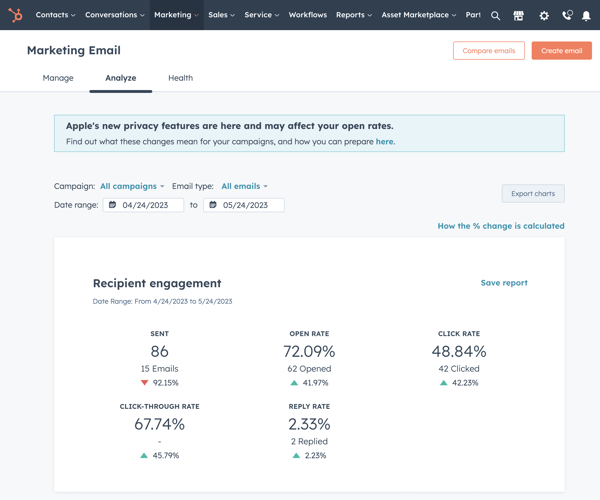
On each of these blocks, you'll notice that not only can you filter and adjust the data being displayed to you, but you can also save those specific views as a report:
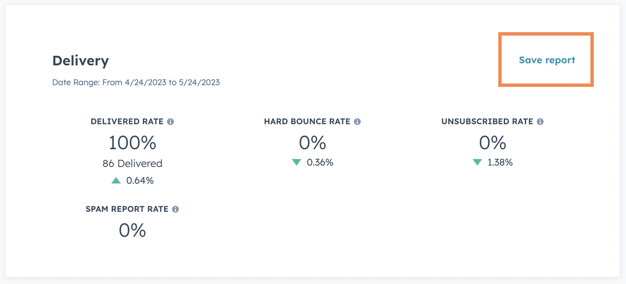
And when you choose to do that, you will have the choice as to whether or not you want to add it to a new or existing dashboard, if at all:
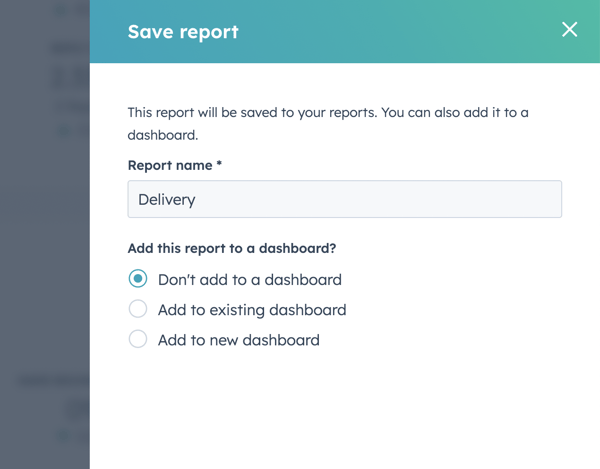
Then there are all the reports you can filter and save within the analytics tool:
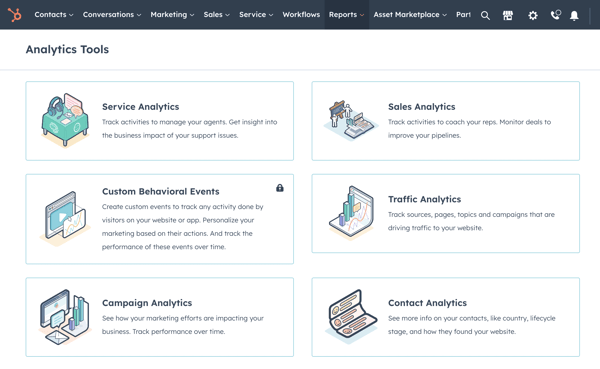
Looking at the sales analytics option, for instance, you've got so many freakin' reporting goldmines waiting for you to unearth them — if they make sense for your goals:
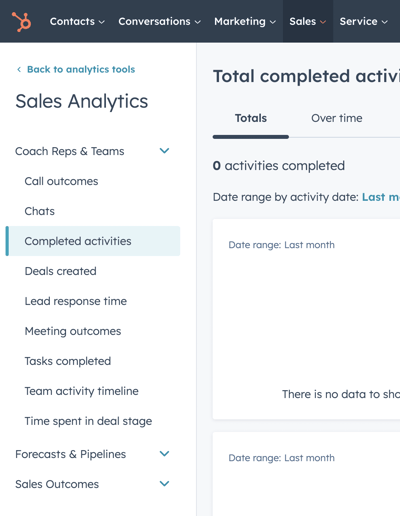
Now, should you save every single report and add it to a dashboard that you can find within the HubSpot analyze tabs or analytics tools?
Heck no!
However, you should put on your Great Collector cap, as you're considering what your reporting should look like, by exploring all of the analyze tabs in HubSpot to see what already exists for you.
🔎 Related: HubSpot reporting mindsets, misconceptions, and disasters (HubHeroes)
How to be the great curator
When you fire up the HubSpot "create reports" option for the first time (under Reporting > Reports), you're going to find 216(ish) pre-built reports at the time that I'm writing this. (Depending on what Hubs you have.)
The last thing you want to do when you load all these puppies is scroll through them.
I've said this before, and I will say it again: Always SEARCH in HubSpot before you scroll for anything.
Virtually every tool or space in HubSpot has search functionality, so you don't have to scroll through endless lists. Use it to save countless hours of potentially wasted time.
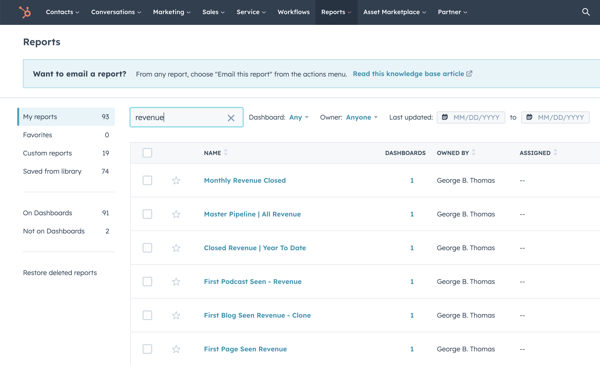
For example, if you're looking for reports about owners, you can search for "revenue," and those reports will populate for you! Regarding your reports, you can also leverage filters based on what you're looking for — deals, companies, revenue, and so on — which I think is pretty freakin' sweet.
And, once more with feeling, you can add any of these reports to a dashboard:
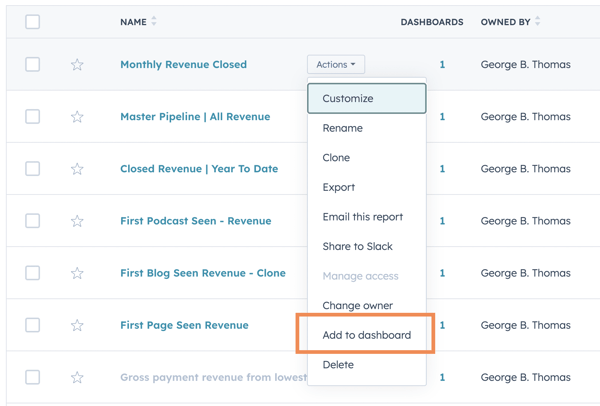
Again, we're in curation mode, right?
That means we need to maximize our abilities to efficiently sort through and gather all of the reports we have at our fingertips. That's really your only goal when you're wearing this particular mindset cap — removing all of the distracting reports that do not serve you, so you can quickly and efficiently measure and manage the right things in HubSpot.
🔎 Related: My ultimate success guide to HubSpot workflows (+ examples)
Finally, how to be the great creator
OK, through this last HubSpot reporting lens, we're no longer collecting and curating what HubSpot has already developed for us.
We need to go beyond that.
This is where we start thinking about custom properties, objects, and groups. These are the building blocks you need to master to create powerful HubSpot reporting that enables you to make smarter decisions faster.
Don't worry. We've made it easy for you with this entire episode of the HubHeroes podcast dedicated to what custom properties, objects, and groups are (and how to use them) — and it's simpler than you might think!
OK, with that bit of housekeeping out of the way, now we can look at the two somewhat easy HubSpot reporting tools you'll need to look at as the great creator: attribution reporting and single object reporting.
Attribution reporting in HubSpot
I like to think of attribution reporting in HubSpot like a Corvette ...
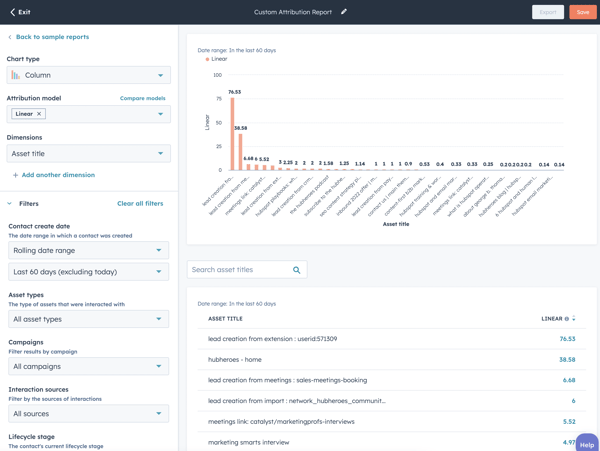
... and all that customization goodness on the left-hand side is how you pop the hood to work on your sweet ride so that it can run smoothly, how you like it.
You can adjust date ranges, drill down into specific campaigns, lifecycle stages, different types of attribution models, and more.
You can even get creative with different options for how your data is displayed:
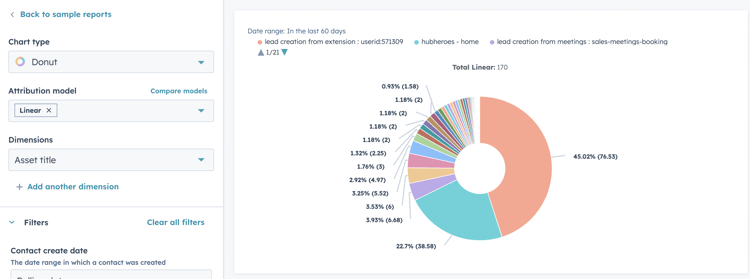
Donut is even a chart type if you're feeling hungry! 🍩
As you continue to refine the report you're building, you can use the filters on the right to really dial in on what you want to see while trimming the fat of what you don't need.
In a nutshell, attribution reporting enables you to see in HubSpot how different assets and touch points are performing in terms of bringing leads and customers to your digital doorstep. If it seems a little daunting initially, don't worry — HubSpot has a dedicated attribution reporting lesson that will leave you feeling like a pro in only 26 minutes!
Single object reporting in HubSpot
We've touched upon this a few times already, but now it's really time to drive this point home — HubSpot is made up entirely of objects (contacts, companies, deal tickets, and so on). This is where single object reporting can be super powerful for you because you can report on a single object rather than being stuck with blended reports ... contacts and companies collide everywhere!
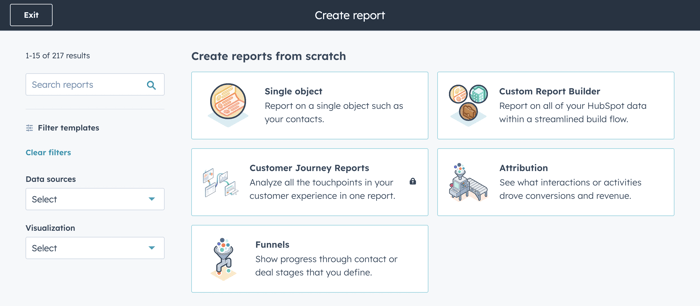
And you can drill down into tons of different single object reporting options:
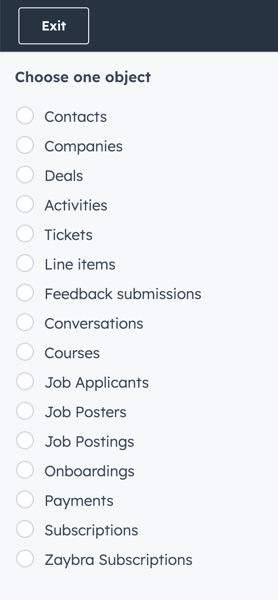
Easy peasy ... 💥
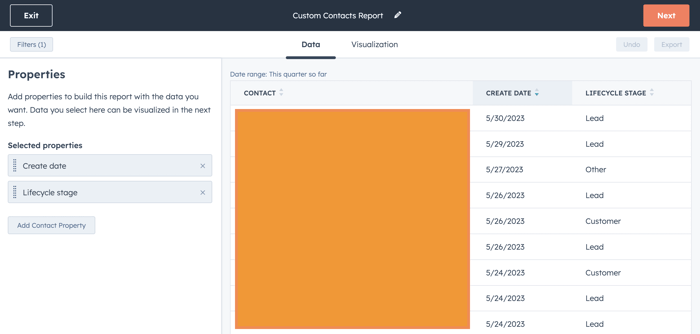
And, much like the attribution reporting in HubSpot, you have a few neat customization options for your reporting, particularly for visualizations.
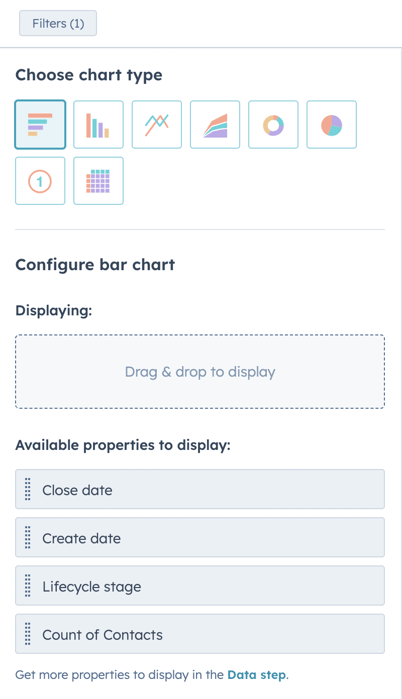
HubSpot has some great documentation — duh — on how to build out more single-object reports within your hubs, depending on your subscription level.
How to think about your reporting
Of course, building your reports is only the beginning. And the last thing your reporting journey should ever be is passive. So, when you start running and reviewing these reports regularly, you should be challenging yourself to translate the data you're seeing into insights that direct action.
You can do this by asking yourself questions like:
- Where are we successful, and why? What's working that we should scale and repeat?
- Where are we sucking, and why? What's not working that we should pull back and rethink? (Hey, it's gonna happen sometimes, ya know?)
Remember, creating a report isn't enough. The data you're collecting, curating, and creating is only as valuable as your actions resulting from what you discover.
🔎 Related: Contacts are the key to HubSpot mastery and ROI
Remember that every single data point you see in every HubSpot report you generate represents a whole-ass human being with thoughts, feelings, needs, challenges, and goals.
It's not enough to simply understand their behavior. You need to go out of your way to leverage those learnings to better attract, engage, and delight the humans you seek to serve.
Oh, for those of you who are wondering about the Custom Report Builder, Funnel Reports, and other dope HubSpot Reporting tools, yes, these mindsets work for those tools as well. But that's a post for another day. Like I said at the start of this bad boy, this is only the beginning of our HubSpot reporting journey together.
If you need help with your HubSpot Reporting education or just HubSpot help in general, reach out and start a conversation. We're here to help!




